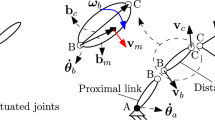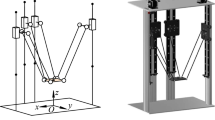Abstract
The Lagrange-I equations and measure differential equations for multibody systems with unilateral and bilateral constraints are constructed. For bilateral constraints, frictional forces and their impulses contain the products of the filled-in relay function induced by Coulomb friction and the absolute values of normal constraint reactions. With the time-stepping impulse-velocity scheme, the measure differential equations are discretized. The equations of horizontal linear complementarity problems (HLCPs), which are used to compute the impulses, are constructed by decomposing the absolute function and the filled-in relay function. These HLCP equations degenerate into equations of LCPs for frictional unilateral constraints, or HLCPs for frictional bilateral constraints. Finally, a numerical simulation for multibody systems with both unilateral and bilateral constraints is presented.
Similar content being viewed by others
References
Pfeiffer, F.: On non-smooth dynamics. Meccanica 43, 533–554 (2008)
Ferris, M.C., Pang, J.S.: Engineering and economic applications of complementarity problems. Siam Rev. 39(4), 669–713 (1997)
Pfeiffer, F.: Unilateral multibody dynamics. Meccanica 34(6), 437–451 (1999)
Pfeiffer, F.: The idea of complementarity in multibody dynamics. Archive of Applied Mechanics 72(11–12), 807–816 (2003)
Pfeiffer, F.G.: Applications of unilateral multibody dynamics. Phil. Trans. R. Soc. Lond. A 359, 2609–2628 (2001)
Pfeiffer, F.: Multibody systems with unilateral constraints. J. Appl. Maths Mechs. 65(4), 665–670 (2001)
Leine, R.I., Van, Campen D.H., Glocker CH.: Nonlinear dynamics and modeling of various wooden toys with impact and friction. Journal of Vibration and Control 9, 25–78 (2003)
Moreau, J.J.: Unilateral contact and dry friction in finite freedom dynamics. In: Moreau, J.J., Panagiotopoulos, P.D., Nonsmooth mechanics and applications. CISM courses and lectures No.302, 1–82, Springer Verlag, Wien (1988)
Brogliato, B., Dam, A.A. ten, Paoli, L., et al.: Numerical simulation of finite dimensional multibody nonsmooth mechanical systems. Appl. Mech. Rev. 55(2), 107–150 (2002)
Pfeiffer, F., Foerg, M., Ulbrich, H.: Numerical aspects of nonsmooth multibody dynamics. Computer Methods in Applied Mechanics and Engineering 195(50-51), 6891–6908 (2006)
Anitescu, M., Potra, F.A.: Formulating dynamic multi-rigidbody contact problems with friction as solvable linear complementarity problems. Nonlinear Dynamics 14, 231–247 (1997)
Gao, H.P., Wang, Q., Wang, S.M., et al.: Linear complementarity model and numerical integration scheme of multibody system with unilateral and bilateral constraints. Journal of Vibration and Shock 27(8), 38–41 (2008)
Glocker, C.H., Studer, C.: Formulation and preparation for numerical evaluation of linear complementarity systems in dynamics. Multibody System Dynamics 13(4), 447–463 (2005)
Glocker, C.H., Pfeiffer, F.: Complementarity problems in multibody systems with planar friction. Archives of Applied Mechanics 63, 452–463 (1993)
Pfeiffer, F.: Unilateral problems of dynamics. Archive of Applied Mechanics 69, 503–527 (1999)
Glocker, C.H.: Set-valued Force Laws: Dynamics of Nonsmooth Systems. Springer-Verlag, Berlin, Heidelberg (2001)
Glocker, C.H.: On frictionless impact models in rigid-body systems. Phil. Trans. R. Soc. Lond. A 359, 2385–2404 (2001)
Studer, C.W.: Augmented time-stepping integration of nonsmooth dynamical systems. Diss. ETH No.17597. ETH Zurich (2008)
Moreau, J.J.: Numerical aspects of the sweeping process. Comput. Methods Appl. Mech. Engrg. 177, 329–349 (1999)
Cottle, R.W., Pang, J.S., Stone, R.E.: The Linear Complementarity Problem. CA: Academic Press, San Diego (1992)
Zhang, P.A., He, S.Y., Li, X.S.: Smoothing iterative algorithms for complementarity problems. Journal of Dalian University of Technology 43(1), 16–19 (2003) (in Chinese)
Xiu, N.H., Zhang, J.Z.: A smoothing Gauss-Newton method for the generalized HLCP. Journal of Computational and Applied Mathematics 129, 195–208 (2001)
Author information
Authors and Affiliations
Corresponding author
Additional information
The project was supported by the National Natural Science Foundation of China (10672007).
Rights and permissions
About this article
Cite this article
Gao, HP., Wang, Q., Wang, SM. et al. A linear complementarity model for multibody systems with frictional unilateral and bilateral constraints. Acta Mech Sin 27, 587–592 (2011). https://doi.org/10.1007/s10409-011-0435-y
Received:
Revised:
Accepted:
Published:
Issue Date:
DOI: https://doi.org/10.1007/s10409-011-0435-y




